Foreign Insulators
by Marilyn Albers
Reprinted from "INSULATORS - Crown Jewels of the Wire", November 1984, page 6
Johnson and Phillips Liquid Insulators
There are bits and pieces of information scattered throughout insulator books
and old catalogues about the liquid (oil) insulators patented in 1876 by two
Englishmen, Walter Claude Johnson and Samuel Edmund Phillips. I have long been
fascinated by these particular insulators and thought it would also be of
interest to you readers to see most of what I've found out about them, and all
in one place.
These insulators were designed to solve the problem created when
dust, dirt and other pollutants contaminated the leakage path and interfered
with the insulation properties of the insulator.
The first design created by
Johnson and Phillips was experimental. It was a thick walled insulator having an
outer skirt (shed) with its rim so turned inwards that it formed a channel for
the oil (a fluid hydrocarbon). The oil had to be fed in from the curved spout of
a special oil can. Most times, this proved to be more trouble than it was worth,
and the oil actually attracted and held the dirt! These designs were used on
early lines in Europe. Three different versions of this first design are shown
below. Lacking actual specimens, but anticipating their eventual discovery, the
drawings were made directly from a Buller Jobson & Company catalogue dated
1885. This company was located in Staffordshire, England. Notice that these old
designs now have their own U-numbers.

Another Johnson and Phillips oil insulator offered in this early Buller
Jobson & Co. catalogue is shown on the following page. It is made in two
parts -- an outer shell, and a separate cup to hold the oil that was designed to
fit up inside the insulator. It has been catalogued as U-2918.
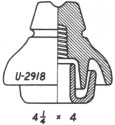
This and the preceding three drawings appear in our book WORLDWIDE PORCELAIN
INSULATORS by Albers/Tod. We assume that the actual insulators were marked with
the Buller's crest, as this company was seldom remiss in doing so!
Our authority on British insulators, Keith Neal, has made two sketches for me
and explained just how these two part insulators were held together. He says,
"The floating (oil) cup is secured by a thick rubber elastic ring slipped
over the pin which can be rolled tightly up to hold the cup after it has been
filled. Below the rubber ring, or washer, there is a two inch copper split pin
driven through a hole in the spindle to make all secure. The split pin can be
knocked out easily (being copper it does not rust), and the rubber ring replaced
if necessary. I enclose a rough drawing of one of my insulators with the rubber
ring and split pin still in position. The rubber has perished! To find one with
its original rubber ring is very rare. I have never dared to move mine as it
would disintegrate !"
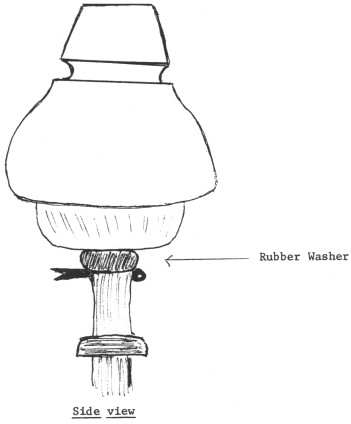
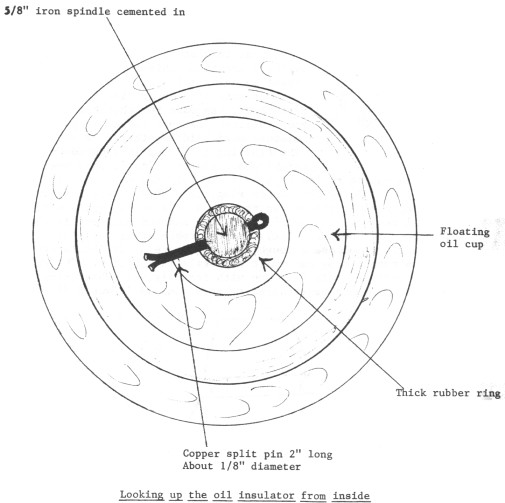
Large Image (73 Kb)
Since our WORLDWIDE PORCELAIN INSULATORS book was published,
three other two part Johnson and Phillips oil insulators have surfaced, and I am
fortunate to have these in my collection now. Two of these designs are shown in
the following photos. Unfortunately, I have misplaced the picture of the third
one, and since Dora is waiting for this column, a drawing (much better, really)
will have to take its place. The drawing was supplied by Keith Neal. Markings of
the manufacturers are also included.
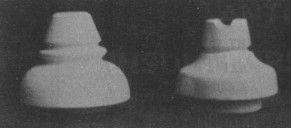
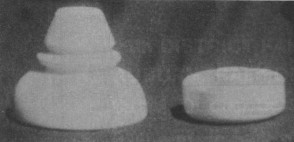
The insulator on the left in the first photo is marked BULLERS
LIMITED (as the Buller Jobson Co. was known after 1890 and until 1959). No date
appears. This insulator still awaits a U-number to be assigned, and it shall
have it in our forth-coming supplement to WWP.
The specimen on the right is nearly identical to U-2918, which
was made by the Buller Jobson Co. However, this one was manufactured by another
English firm, G & G Insulators (Gaskell and Grocott). This company was
located in Stoke on Trent and was in operation just short of 100 years -- 1870
to somewhere between 1969 and 1970. So obviously Johnson and Phillips oil
insulators were not made exclusively by Bullers!
The second photo shows the Bullers insulator separated into its
two parts, with the oil cup lying beside the outer shell.
Looking at the drawing on the following page, you see a third
and rather unique version of a two part oil insulator. Keith Neal made a copy of
a drawing found in still another Bullers catalogue, and you can see that the oil
cup here is designed to screw directly up into the insulator. The specimen that
I have in my collection is missing this inner cup, and I didn't know what I had
until Keith identified it for me. Was I thrilled to learn that it is pretty
rare. Even he doesn't have one! It is marked with the Bullers crest and dated
1952.
In reading the words below the drawing, you will discover that
this is a special type of oil insulator designed for use in coastal areas where
salt laden winds were a problem: Iraq, India, Palestine, Ceylon and Gibraltar.
Also notice the method of replacing the oil cup. Very carefully!
You can consider yourself fortunate if you have any one of these
in your collection. If I have driven you batty by referring to them as oil
insulators, when the title of this article calls then liquid insulators, please
know that the two terms, in this case, are interchangeable!
| 